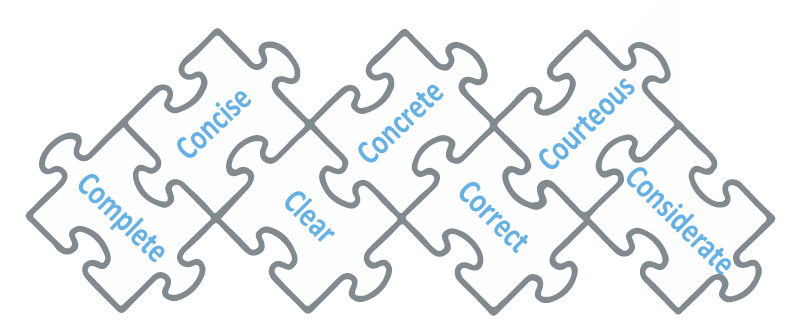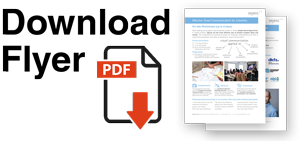The »7 C’s of Effective Communication« Applied to Science
The concept of »7 C’s of Effective Communication« first appeared in business, where time is precious and there is no room for mistakes done out of misinformation. The »7 C’s« stand for seven essential principles of communication starting with the letter C. Each one represents a requirement that the message should meet to be effective. Applying these principles to your communication ensures that your message will be in sync with the recipient’s understanding and free from ballast.
Modern science is not much different from business in the sense that scientists face information overload. Oral presentations are the biggest problem in this respect: how many conferences or seminars have you attended where no speaker talked too fast or extended their talk over the allocated length because they wanted to squeeze too much information in too little time? When dealing with written communication, for example when reading research papers, scientists adapt to time shortage by skimming for key information, and read in depth only the most interesting parts. In both cases, if the communication is ineffective, the main message of your work will be obscured or lost. You risk missing opportunities to be cited or invited for collaboration.
In this post, we reinterpreted the »7 C’s« of effective business communication to fit scientific purposes. They are applicable to both oral and written communication.
1. Clarity: Simplicity & Organization
Clarity is best achieved through short, simple and fluent sentences and paragraphs. Each paragraph should describe only one idea, and paragraphs should be organized from »the big picture« at the beginning to greater detail towards the end. The last sentence in a paragraph should indicate the information in the next paragraph. Appropriate idea flow ensures that the readers are exposed to right information at the right time, especially if they are not from your immediate scientific field.
Clarity is interconnected with the principle of completeness and concreteness.
2. Conciseness: Get to the Point
Conciseness means forming your message with minimum number of words possible without invalidating the other 6 C’s. Avoid wordiness, repetition, and filler words or phrases, such as »in short«, »as stated before«, »due to the fact that«, »this is the first study«, etc. This is particularly important in project proposals or research papers with strict word limits. Concise message is also more appealing and comprehensible, and will save time both to you and your audience.
Conciseness is interconnected with the principles of concreteness and consideration.
3. Concreteness: Specifics Instead of Generalizations
Concrete message is like a factsheet put to words. For example, it is much better to say »In the review of the period from 2010 to 2015, A & B (2016) found that 75 % of publications from the research area of X reported on the phenomenon of Y« than »The phenomenon of Y has become increasingly recognized in the recent years«. Avoid also vague words and words with multiple meanings, such as »in the future«, »several«, »quickly«, etc. Concreteness diminishes the need to guess the meaning and the possibility of misinterpretation.
Concreteness is interconnected with the principles of clarity, conciseness and consideration.
4. Completeness: No Necessary Information is Missing
A complete message should convey all facts required by the audience. In interdisciplinary research, for example, your reviewers might be from another scientific field. It is therefore wise to include more general information than you normally would if you wrote a paper within your narrow expertise. On the other hand, there is no possibility for corrections or follow-up in the revision process of project proposals. You thus need to ensure that reviewers have all the facts at hand if you wish that your project is convincing.
Completeness is interconnected with the principles of clarity and courtesy.
5. Correctness: Facts & Proofreading
Correctness refers to both factual and linguistic accuracy. All the information you provide needs to stem from valid, reliable, and credible sources that can be located. This is the reason why Wikipedia is not accepted as an information source for scientific publications. Correctness is fundamental in research paper discussions, where your claims need to be supported with facts and figures from your results. Finally, you should always check your writing for typing, spelling, and grammatical errors. If English is not your mother tongue, it is wise to consult professional language editing services.
Correctness is interconnected with the principle of consideration.
6. Courtesy: Stepping Into Audience’s Shoes
Courteous message is written from the viewpoint of the audience. If you prepare a seminar about your latest discovery, you will need to provide background information for your students, but you can skip those and get right to the details for your coworkers. Messages for general public should always highlight the societal benefits of your research. Courtesy requires some thinking about what the audience knows or doesn’t know and forming the message accordingly. However, it is also a way of showing respect.
Courtesy is interconnected with the principle of completeness.
7. Consideration: Scientists are People, Too
Just because scientists are able to deal with complex ideas and tons of information, it doesn’t mean that they are able to deal with a flood of unformatted text. Whatever document you are preparing, be considerate and use visual design to make the main messages stand out. Figures, paragraphs, headings, bulleted lists, and highlights are tools you can use to make your paper, poster, or project proposal more appealing and comprehensible. Consideration also entails good language. Visually or linguistically, your message shouldn’t look as if it was prepared in a hurry!
Consideration is interconnected with the principle of correctness.
Conclusion
Use the »7 C’s of Effective Communication« as a checklist when you make your next research paper, project proposal, conference presentation, or lecture. The better you communicate, the more credibility you’ll have with your colleagues, students, readers, reviewers, and general public.
[social_warfare]

Tea Romih (PhD in Nanotoxicology, 2016) is the Seyens.com editor and advisor at Seyens Education Institute, responsible for communication between researchers and illustrators.



Sean
October 10, 2018 (11:29 am)
This is amazing- do you have samples of assessments that I can use for each of these as concepts to effective written communication?
Eric Mwirigi
October 10, 2019 (8:21 am)
Your notes are clear and precise can I get a PDF of the notes regarding this unit of communication
ALI MUHAMMAD KHAN
July 11, 2020 (9:11 am)
how can we implement 7 C’s of communication in our professional and personal life?
Sohail
July 17, 2020 (5:42 am)
Plz give us topic which have all 7cs ?
sheikh faizan gul
October 30, 2021 (2:35 pm)
brother have you got topic which have all 7c of effective communication if you have please share with me where from i get idea please
thank you
naeem abdullah
October 22, 2020 (3:59 pm)
Example of each communication
Hameedullah
November 27, 2020 (2:11 pm)
Please Give me some Examples Of Correctness
Sumera
November 1, 2020 (5:39 pm)
Kindly give the every C’s with 5examples
YousafKhan
January 10, 2021 (4:49 pm)
7C
Hamid Shehzad
June 29, 2021 (9:13 am)
Teri aa pehn da phapar
Shehzad Khan
August 22, 2021 (4:30 pm)
bhenki kuss teyri
Ahmed
February 23, 2022 (9:03 pm)
Aoa. .plz give me that pargraph answer
Victoria Nkantion
March 22, 2022 (1:37 pm)
Thank you Muhammad, this was extremely useful article for my today studies.
kathiravan
July 22, 2022 (9:47 am)
7c
Ummama
June 16, 2023 (12:25 am)
These are such a standardized notes